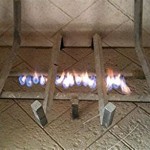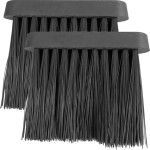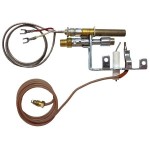Wood Trim for Fireplace Surround: Enhancing Aesthetics and Defining Style
A fireplace serves as a focal point in many homes, offering warmth and a sense of comfort. The fireplace surround, the decorative framework around the firebox, plays a crucial role in establishing the style and visual appeal of the fireplace. Among the various materials used for fireplace surrounds, wood trim stands out for its versatility, natural beauty, and ability to complement diverse architectural designs. This article explores the aspects of using wood trim for fireplace surrounds, covering material choices, design considerations, installation methods, and long-term maintenance.
Material Selection for Wood Trim
The selection of wood is a critical decision that impacts the appearance, durability, and cost of the fireplace surround. Different wood species offer varying characteristics in terms of grain pattern, color, hardness, and susceptibility to warping from heat and humidity. Consider the following wood types:
Hardwood: Hardwoods, such as oak, maple, cherry, and walnut, are generally more durable and resistant to dents and scratches compared to softwoods. Oak is a popular choice due to its strength, distinctive grain, and availability. Maple provides a smoother, more uniform texture and is suitable for painting or staining. Cherry offers a rich, reddish-brown hue and a fine grain, while walnut boasts a dark, sophisticated appearance and exceptional stability. These woods are suitable for high end and traditional design, providing lasting beauty.
Softwood: Softwoods, including pine, fir, and cedar, are typically more affordable and easier to work with than hardwoods. Pine is commonly used for rustic or farmhouse-style fireplace surrounds due to its knotty appearance and ability to accept paint or stain readily. Fir offers a straighter grain and a lighter color than pine. Cedar is naturally resistant to decay and insects, making it a good option for homes in humid climates. However, it is generally more expensive than Pine or Fir.
Engineered Wood: Engineered wood products, such as MDF (Medium-Density Fiberboard) and plywood, offer a consistent and predictable material for fireplace surrounds. MDF is a dense, smooth material that is ideal for painting and intricate detailing. Plywood provides strength and stability, and it can be veneered with a variety of wood species to achieve a desired look. Engineered wood is less prone to warping than solid wood and is a cost-effective alternative.
When selecting wood, it's essential to consider the overall style of the room and the existing architectural details. The chosen wood should complement the flooring, furniture, and trim work in the space. It's also crucial to ensure that the wood is properly dried and seasoned to minimize the risk of warping or cracking after installation. Furthermore, ensure the selected wood meets local building code requirements related to fire resistance.
Design Considerations for Wood Trim Fireplace Surrounds
The design of the wood trim fireplace surround significantly influences the overall aesthetic of the room. The design should not only be visually appealing but also functional and proportionate to the size of the fireplace and the room. Consider the following design aspects:
Style: Choose a style that aligns with the architectural style of the house. Traditional styles often feature ornate carvings, raised panels, and decorative moldings. Modern styles tend to be more minimalist, with clean lines and simple geometric shapes. Rustic styles embrace natural textures and imperfections, often incorporating reclaimed wood or rough-hewn timbers. Farmhouse styles combine rustic elements with clean lines and a focus on practicality. Transitional styles blend traditional and modern elements to create a balanced and timeless look.
Proportion: The size and scale of the fireplace surround should be proportionate to the dimensions of the fireplace opening and the room. A surround that is too large can overwhelm the space, while one that is too small may appear insignificant. Consider the height of the ceiling, the width of the wall, and the overall size of the room when determining the dimensions of the surround. The width of the trim used also contributes to the perceived weight and balance.
Details: The details of the wood trim can add visual interest and character to the fireplace surround. Consider incorporating moldings, panels, carvings, or other decorative elements to enhance the design. Moldings can be used to create depth and dimension, while panels can add texture and visual interest. Carvings can add a touch of elegance or whimsy. Ensure that the details are consistent with the overall style of the surround. For example, crown molding is appropriate for traditional designs but may seem out of place in a modern space.
Mantel: The mantel is a prominent feature of the fireplace surround that provides a display surface for decorative objects. The mantel should be proportionate to the size of the surround and should be positioned at a comfortable height. Consider the material, style, and finish of the mantel to ensure that it complements the wood trim. A thick, solid wood mantel can add a sense of substance and craftsmanship, while a thinner, more streamlined mantel can create a more modern look. Ensure that the mantel is properly supported and can safely hold the weight of any items placed on it.
Firebox Opening: The design should frame the firebox opening attractively. The opening shape, whether rectangular, arched, or custom, should be considered in the overall design. Pay attention to the reveal, the amount of firebox exposed. Consider surrounding the firebox with a non-combustible material like tile or stone for additional safety and aesthetic contrast.
Installation of Wood Trim Fireplace Surrounds
Proper installation is essential for ensuring the safety, stability, and longevity of the wood trim fireplace surround. It is generally recommended to hire a qualified carpenter or contractor to handle the installation, especially for complex designs. However, experienced DIYers can also tackle the project with careful planning and execution. Consider the following steps:
Preparation: Before beginning the installation, carefully measure the fireplace opening and the surrounding wall area. Create a detailed plan or drawing that outlines the dimensions, placement, and attachment methods for each piece of trim. Gather all necessary tools and materials, including wood trim, fasteners, adhesive, measuring tape, level, saw, drill, and safety glasses. Ensure the existing fireplace structure is structurally sound and free from any combustible materials within the required clearances. Adhere to manufacturer instructions and building codes regarding fire safety.
Cutting and Fitting: Accurately cut each piece of wood trim to the required dimensions using a saw. For angled cuts, use a miter saw to ensure precise joints. Dry-fit each piece to ensure a proper fit before applying adhesive or fasteners. Make any necessary adjustments to ensure that the trim is flush with the wall and that the joints are tight and seamless. Pay particular attention to corners and intersections, ensuring they meet cleanly and accurately.
Attachment: Secure the wood trim to the wall using construction adhesive and fasteners, such as nails or screws. Apply a bead of adhesive to the back of each piece of trim and press it firmly against the wall. Use a nail gun or drill to drive fasteners through the trim and into the wall studs or framing. Ensure that the fasteners are countersunk and that the trim is securely attached to the wall. For heavier pieces of trim, consider using additional support, such as cleats or brackets.
Finishing: After the trim is installed, fill any nail holes or imperfections with wood filler. Sand the filler smooth and apply a primer to the wood trim. Paint or stain the trim to match the desired color and finish. Apply multiple coats of paint or stain, allowing each coat to dry completely before applying the next. Apply a clear coat of varnish or polyurethane to protect the finish and enhance its durability. Caulk any gaps between the trim and the wall to create a seamless and professional look.
Safety Considerations: During installation, prioritize safety. Wear safety glasses to protect your eyes from dust and debris. Use a dust mask to avoid inhaling sawdust. Follow the manufacturer's instructions for all tools and materials. Be mindful of electrical wiring and plumbing pipes that may be located behind the wall. Do not install any combustible materials within the required clearances of the firebox. Consult local building codes and regulations regarding fireplace construction and installation.
Clearances: Maintaining proper clearances to combustible materials around the firebox is vital for fire safety. Building codes specify minimum distances for wood trim and other combustible materials from the firebox opening. Following these guidelines prevents the surround from overheating and potentially igniting. Consult with a qualified inspector to fully understand and comply with local codes.
Maintaining Wood Trim Fireplace Surrounds
Proper maintenance is essential for preserving the beauty and longevity of the wood trim fireplace surround. Regular cleaning and care can prevent damage from dust, smoke, and heat. Consider the following maintenance practices:
Cleaning: Regularly dust the wood trim with a soft cloth or brush to remove dust and debris. Periodically clean the trim with a mild soap and water solution. Avoid using harsh chemicals or abrasive cleaners, as these can damage the finish. For stubborn stains, use a specialty wood cleaner that is specifically designed for the type of finish used on the trim. Wipe the trim dry with a clean cloth after cleaning.
Protection: Protect the wood trim from excessive heat and humidity. Avoid placing flammable objects too close to the firebox opening. Use a fireplace screen to prevent sparks from damaging the trim. Ensure proper ventilation in the room to prevent the buildup of moisture. Use a humidifier to maintain a stable humidity level in the room, especially during the winter months. Too much humidity can cause wood to swell, while too little can cause it to crack. Consider applying a heat-resistant finish to the wood trim near the firebox opening to provide added protection from heat damage.
Repair: Inspect the wood trim regularly for signs of damage, such as cracks, chips, or fading. Repair any damage promptly to prevent it from worsening. Fill cracks and chips with wood filler and sand smooth. Touch up the finish with paint or stain to match the existing color. Reapply caulk as needed to seal any gaps between the trim and the wall. Consider consulting with a professional woodworker or contractor for more extensive repairs.
Refinishing: Over time, the finish on the wood trim may become worn or faded. Consider refinishing the trim to restore its original beauty. Remove the old finish by sanding or stripping. Apply a new primer and paint or stain. Apply a clear coat of varnish or polyurethane to protect the finish. Refinishing can significantly enhance the appearance of the fireplace surround and extend its lifespan.
By carefully selecting the right materials, considering design elements, and following proper installation and maintenance practices, homeowners can enhance their fireplace surrounds and add lasting beauty to their homes. Wood trim, with its warmth and versatility, can transform a simple fireplace into a stunning focal point.

Fireplace Redo After With White Wood Trim Rustic Mantelshelf And Black Painted Firebox Home Remodel

White 52 Inch X 39 Wood Fireplace Mantel Surround Kit With Shelf And Trim Essex From Mantels Direct Poplar Wooden Chimney Com

Diy Fireplace Finished Addicted 2 Decorating

How To Add Wood Trim Above Fireplace Mantle

53 Best Fireplace Mantel Designs To Ignite Your Creativity Home Remodel Marble Surround

Diy Fireplace Part 5 Trim Grout And Mantel Addicted 2 Decorating

Fireplace Mantel Trim

Diy Farmhouse Trim Above The Fireplace Top Shelf

How To Add Wood Trim Above Fireplace Mantle

Diy Faux Plaster Fireplace Surround Chelsey Freng
Related Posts








